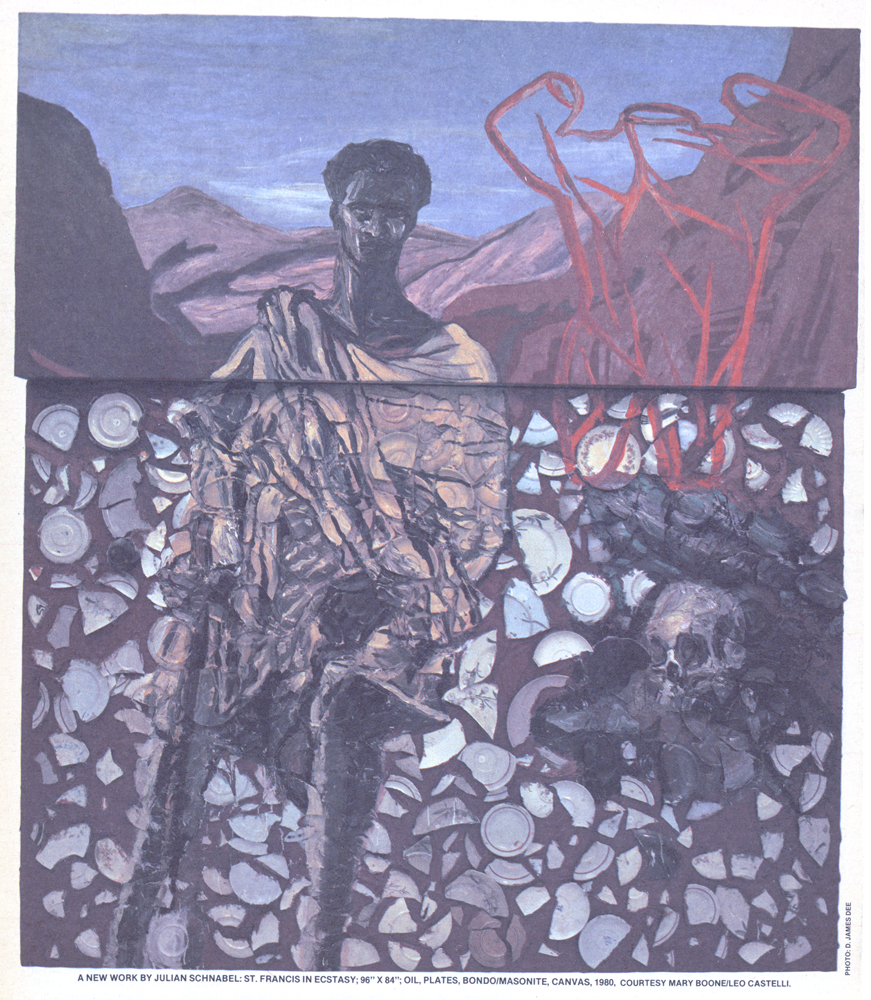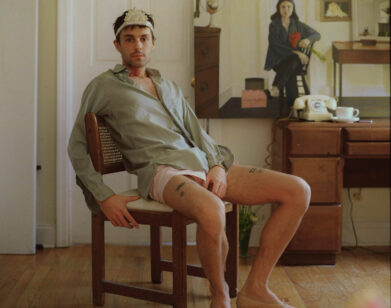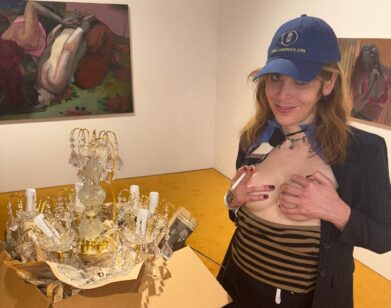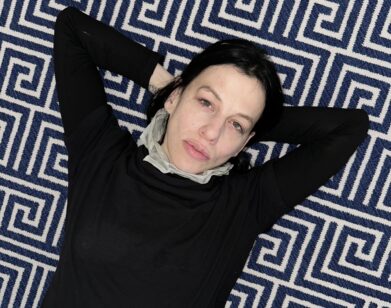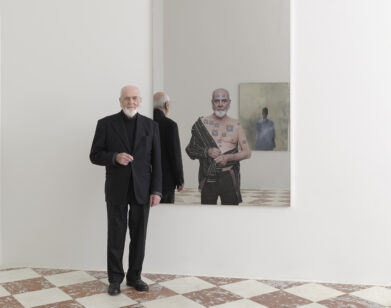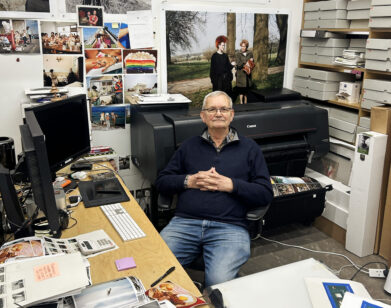New Again: Julian Schnabel
Known for everything from large-scale paintings on broken ceramics (also referred to as “broken plate paintings”) to documentaries and films like Basquiat, Julian Schnabel‘s career as an artist will seemingly never end. Many of his children are following him into the art world, including Vito Schnabel, who curated his first exhibition at age 16 in 2003. Since then, Vito has become a recognizable curator and art dealer. Until last week, however, he never had a physical space to call his own. On December 28, 2015, Vito opened Vito Schnabel Gallery in St. Moritz, Switzerland with an inaugural exhibition of works by Urs Fischer. Entitled “Bruno and Yoyo,” the show pays homage to Bruno Bischofberger, Vito’s mentor and also the man from whom he overtook the gallery space. The gallery works with an impressive roster, including Julian, Fischer, Sterling Ruby, the Bruce High Quality Foundation, Laurie Anderson, Rene Richard, and more. In honor of the opening of Vito’s first gallery (we’re guessing there will be more locations to come), we’ve reprinted an interview with his father from October 1980, the year following his defining show at Mary Boone Gallery.
Art to Art
By Carter Ratcliff
From Zurich to SoHo, Julian Schnabel is the talk of the contemporary art scene. Fresh from a success at Bruno Bischofberger Gallery last spring, followed by a summer of hard work in his Chelsea studio, Schnabel will show at Young-Hoffman in Chicago this month, then return to New York for the installation of “A Large Wall Symbolizing Fate’s Inaccessibility” for February viewing at Leo Castelli’s Greene Street branch. Schnabel’s big moment comes, though, in April 1981, when he will have a one man show at Mary Boone and Castelli, practically taking over 420 West Broadway.
CARTER RATCLIFF: How long have you been in New York?
JULIAN SCHNABEL: I’m from New York originally. I was born here. I lived in Texas for a while and came back here about seven, eight years ago. In 1976, I went back to Texas; I made some paintings for a show at the Contemporary Arts Museum in Houston and Jim Harithas.
RATCLIFF: Yes.
SCHNABEL: It was a very short show. A two-week museum show—who knows what it filled in. Then I came back to New York, then I went to Italy for a while through the fall of ’76 and the spring of ’77.
RATCLIFF: Where in Italy?
SCHNABEL: Milan. And then I travelled around…
RATCLIFF: What were you doing? Making art?
SCHNABEL: Yeah, I made some paintings there, and I was looking at old paintings I went to Padua.
RATCLIFF: What about school?
SCHNABEL: I went to the University of Houston. It was worse than not being in school, just completely repressive. But there were some people around that cried with me, over my mistakes or something…There were some young artists who were doing interesting things, but I don’t think people are terribly interested in young artists who were doing interesting thing, but I don’t think people are terribly interested in young artists. And then I came back to New York. I was in the Whitney Independent Study Program for a little while and then I just lived here, lived everywhere—Reade Street, Beekman Street, Leonard Street. I met Malcolm Morely around then.
RATCLIFF: How did you meet Mary Boone?
SCHNABEL: Through Ross Bleckner. I used to cook in the Lo-Cal Restaurant. Maybe I met her there, and asked her if she wanted to see some painting so she came over to my studio. And then, I think without anybody telling her what to do, just by her own intuition, she said we would do something. I was waiting around a little while, but I thought it was good because it was a painting context.
RATCLIFF: When was your first show?
SCHNABEL: It was in February of ’79.
RATCLIFF: But I’d seen your paintings before. Was it in group shows at Mary Boone or…?
SCHNABEL: I had a painting in a group show at Holly Solomon’s the season before that, and there was an independent study show at the Whitney in ’74 and then one in Chicago. Where else could you have seen them? There was an article in ArtRite magazine about them. I don’t know—I was always trying to show them to somebody. I wanted to show painting paintings first, then the plate paintings; now I can show that I’ve sort of freed myself from stylistic inhibitions. I think style is a fringe benefit that looks like you made it. I like to use as many different kinds; I don’t like collecting all this stuff, and I don’t like building, I’m not a carpenter, I don’t like constructions particularly and things like that, but placements and the kinds of psychological weight that different materials have is pretty interesting to me. What gold is about, you know? Or what fur is like? Like when you think of Bugatti furniture, or like the upholstery in cars… When things become symbols of fascism. Or what fascism means to us. Or what our notions of what classicism are—how we might have an idea about some classical figure, it might be a man in an army uniform or something like that. Because everything I’ve experienced is somehow assimilated information, as if I lived in the movies—just seeing films about things—but never really living it. I guess it’s just a kind of distant place.
But I’m not terribly interested in just that sort of source material. I think I’m just as interested in finding an old drawing that I might have made, or a drawing that somebody else made, or a photograph that might have certain kinds of location in it. Even a group of words, you know, that stick in your head. Pablo Neruda wrote this line where he just says, “In some lost location of summer we stand with parched lips possessed by thirst beneath a rain of kisses.” So somehow, I take these things so personally and literally that I’m there and that is a place. I might pick a color to describe that place, but I don’t ever think that when I make work. It’s not descriptive; I think it’s about observing observation. There’s always that kind of barometer built into it. I think people have problems sometimes when things are too general. In fact, they are not really general at all. Some might seem a little harder, some might seem more hermetic than others, but I think that’s okay too. I think, basically, I’m an abstract artist. I just think that that’s not even an issue. I think everything’s abstract. I’m not mannerist. I don’t think I’m interested in mannerism. If I ever use it in a way, or if manner is like some kind of product of certain sorts of usage of different kinds of materials, then it’s about involution or turning in on that. So I think it’s always critical, I mean I want it to be critical. I mean this aborigine painting, it’s like the head is from an Australian black, from a how-to book, I just wanted it all to get reduced to some sort of emblem, in a way, but I don’t want the emblem to be an emblem that is just synonymous for all of the work; I just want the ideational space that it puts you into to be the same. I want the space that all the different images put you in to be the same. And I think the paintings, some are very heavy and some could be very light, but I think in a way, they still have the same sort of weight and opacity. It’s some kind of physical stop sign or frontality that they have that force you to deal with them as a painting. And I think that painting is irreproachable, or it should be. If it can’t be irreproachable then it’s not terribly interesting painting. I mean you might like a passage in some paintings or think that that’s great, that specific thing, but you have to think the whole painting… or, not think about the painting at all, just have the experience of seeing.
RATCLIFF: But say when you have a color or let’s use the passage of Neruda, the viewer is probably not going to think about that particular message.
SCHNABEL: Right, right. What I’m saying is just that I’m coming form a very personal kind of place. It’s all about memory, and everything gets reduced. Everything I’ve seen becomes real once it becomes memory. The films I’ve seen are interchangeable with things that have really happened to me.
RATCLIFF: Yes.
SCHNABEL: A place that I might have read about is interchangeable with a place that I might have been. And feelings that I have about being in these places, or recognitions, are the things that I catalog in my paintings. So I’m not really saying that someone is going to think about this thing in this way, I’m just talking about my sources. You know, maybe I have to dress myself up in gold—not that I do—or put a suit and tie on to paint, so I would feel like some mythic ghost came in, was sitting there… I mean, certainly you talk to someone when you paint. I guess you talk to yourself. There is some anonymous audience, or somebody there. I think it’s your own ghost, seeing the work and just thinking if it will be okay to leave that around. I have a completely romantic idea about making paintings, I guess. Emotion…You know, Mondrian said he didn’t want to paint any curved lines because there was too much emotion in them, but certainly there was emotion just the way he painted his straight lines, the way the brush mark lies on the surface of the painting. And then, maybe my work looks a little crazy, a little insane, but I don’t really see myself as a crazy artist or a shaman artist. Some people might think that the paintings are involved with a mythic—not just subject matter—but a certain sort of physical space that the paintings occupy…like personages. Like Macbeth was here. I like when people get really close to the paintings, when they can’t really get away from them, I like them to operate in that way on the viewer.
On the other hand, the other side of that, I think that these paintings on velvet are very different than the plate paintings. They’re much more feminine paintings, in a way. But on the other hand…I think it’s liberating to be able to work like that. Maybe it’s greed, but I want to do a lot of work.
RATCLIFF: How did you start using plates?
SCHNABEL: I started using them in ’78. I made two paintings in September, October ’78 with plates. And I was already using wax and building up a surface, and using modeling paste to build things out of paintings. And then I was in Barcelona for a while that summer and looked at Gaudi’s work; it had a certain kind of reflective quality and density of color and light that I felt hadn’t really been used in painting, that was sort of off the ground and had a…pictorial possibility, besides the psychological one.
RATCLIFF: What is the psychological one?
SCHNABEL: Well, I mean it’s the way that the plate functions in the world. It’s sort of treating it like junk, in a way, like stuff. Just the way, if there were shelves in a painting before, or a hole cut out of it, I would paint a line through it or over it. It’s like pointing out something that you’re going to disregard. And then the plates create a kind of surface when they’re painted over. It’s about usage, it marks a period in history. And the paintings get used also; I see them as tools. The fur, or the velvet… The correlations to the subjective collective! The collective modern ideas about what materials exist in the world, where they fit, have a way of cueing us as to where we fit. In terms of where we are, what we think about, memory.
RATCLIFF: So, the different materials in the painting help the viewer find a place in relation to all those memories?
SCHNABEL: Well, I don’t know if they help the viewer. I mean, I think that what they do is confound the experience. They make the painting into something that it’s not, or they make something that it’s not into something that it is. They have an allusive quality. It’s not like: How little can I put in it and it will still be good? It’s not coy. It’s how much can I give for something else to happen that is not here? It’s the dialectic. I mean, Picasso said, “The only things that my paintings lack is lack of imagination.” Inclusion, curiosity. When Rene Ricard wrote about them, he said he saw the plates as like a prosthesis for paint; they were an extension of what paint could do, because paint wasn’t enough. I think basically I’m a painter, but I would use anything to make my point—well, I don’t know if there is a point to be made, but…
RATCLIFF: Has anybody said your work is “too sculptural?”
SCHNABEL: A couple people said it wasn’t painting, but what better compliment could somebody give you than that? They are things in the world. They are the perimeters where you are allowed to be, that have these sort of alchemic powers. I want this kind of beauty, you know. I think beauty is a feeling that you get after you’ve had an experience. It’s the way you feel about it that is beautiful. I don’t know if I could, like, see a face and know what the face of beauty looks like, but after I’ve seen it I know if I’ve felt like it was beauty. I want the paintings to take me or the viewer out somewhere else. They are not just a catalog of ideas, they are made for a different kind of human time—I think they’re very old fashioned.
RATCLIFF: This idea “the subjective collective,” I think the first time I ran across that phrase was in an interview you did in ARTS magazine.
SCHNABEL: Well, I mean it’s not my idea at all. I remember reading an essay in Chicago on tendencies of European art in the ’70s, and they were talking about Piero Mazoni’s and Beuys’ work being involved with that. And they thought that was the beginning of an avant-garde era, whereas they spoke of Klein’s work—because it’s narcissistic materialism—as the end of an avant-garde era. Being done at the same time, the beginning of the ’60s. It was very interesting. And then, after a while, those issues kind of disappear and you just select things. There is no personal language.
RATCLIFF: So you don’t put any value on the strangeness of your paintings? The fact that most people don’t have these plates in their paintings, is not in itself, the fact that you do this—
SCHNABEL: I don’t think the meaning in my paintings comes from just using broken dishes.
RATCLIFF: So these things have a lot of presence but they are not there simply as objects reduced to their physical-
SCHNABEL: Right. But what does happen is that the selection with which the images get placed are literal. So what happens is—like I said, I wanted to make generic paintings? I’m picking these images like they were objects and so I’m selecting them in the same kind of way that I’m selecting the materials that I’m making the paintings out of.
RATCLIFF: How do you mean generic?
SCHNABEL: Generic meaning universal, generic meaning general, generic meaning picking something, like National Geographic generic…I mean, like, I’ve never been to India, or the Khyber Pass, I mean it’s all assimilated information. I want people to have the sort of experience that I long to have, so if they are strange, maybe their strangeness is my way of putting off for a minute, and then, you know, roping them in. I don’t see it as collage imagery, it all happened like the big bang theory! I mean, making the paintings is so fundamental. And seeing them, I just think that they’re real primal, the kind of impulses and recognitions that exist in paintings and because of certain ways of putting things together, and usage. They are not totemic. And they become, they function as another kind of language. I don’t know if language would be the right word, but I think that they do set up another kind of context. Do you think that’s true?
RATCLIFF: Yes, I think I know what you’re getting at. I think it works that way. But the difficulty about talking about it is that it’s something that’ in the quality of experience. And it has to do with getting beyond the kind of analytical language that you use to try to say what it is. So there is a basic difficulty in trying to explain…
SCHNABEL: Yes, that’s exactly true. I’m talking about the quality of feeling.
RATCLIFF: Because a lot of the things you’ve said seem to be kind of analogs to what’s going on in the paintings—but an analog is not an analysis. And if what you’re trying to describe is some sate that’s beyond the ordinary kinds of analysis, breaking things down and compartmenting them, then it’s going to be impossible. I think that’s true about just about all art that’s the real thing. That you can’t break it down, and if you could it would be something else—science perhaps, or logic.
SCHNABEL: I think that parallels what I said about paintings being irreproachable. You talk around it. There is an arbitrary quality about the selection of images that I think has a lot of power. Because I’m feeling a kind of distance and I sort of have everything here and I’m almost like a kid with blocks, you know, putting this together and put that that together. I don’t think my paintings are self-conscious but you feel the consciousness of them. Without them being self-conscious.
RATCLIFF: That’s tricky, because most of the time when you say a painting is self-conscious, people think you mean it’s awkward. Or it’s embarrassed about itself or something. But the other thing that self-conscious means is conscious of the self…
SCHNABEL: Responsibility! For itself, I the world. Being alert and alive to itself, in that sense. Weight…I think all of those thing shave a kind of weight, where they take off and they exist in some other sort of realm.
RATCLIFF: Is Jasper Johns important to you?
SCHNABEL: Not particularly. I mean, he’s important to everybody. I like Brice Marden’s paintings. Blinky Palermo’s. Jackson Pollock is one of my favorite painters. I think he’s great. They are really dense. The Demoiselles D’Avignon is one of my favorite paintings.
RATCLIFF: You seem to spend half your time in Europe and half here.
SCHNABEL: I had a show in June at Bruno Bischofberger. And I was in the Biennale in Venice, so I was installing work there. and I had a show in Germany a couple years ago, so I went there. And it just seems like I’m going back and forth. And then I got married in Belgium. I like to look at paintings there, also. I love Italy in particular. I think Duccio’s great.
RATCLIFF: Because a lot of New York artists don’t get out and around. I mean, it’s surprising to find out someone, some New York artist, is 65-years-old and has never been to Europe.
SCHNABEL: Well, there are certain times you want to be here and there are certain times you want to just go. And when you go, it’s usually so exhausting you have to check into a hospital when you come home! Though I haven’t really been traveling around lately, some people just travel around in their heads, you know? I go to the movies a lot. I like Herzog—Kasper Hauser, Even Dwarfs Started Small…
RATCLIFF: Did you see Aguirre, the Wrath of God?
SCHNABEL: Yeah, it’s great. It has a special place in my heart. I like Samurai films, too. I’ve seen a lot of Kung Fu films lately.
RATCLIFF: Where do you see them?
SCHNABEL: Lots of different places. The Pagoda, down in Chinatown…there are three places down in Chinatown. My wife does Kung Fu, so that’s nice. I love the color of those films. They’re like fairytales.
RATCLIFF: At this point, do you feel satisfied with the way people respond?
SCHNABEL: I mean, I a certain way, my work had set me up to be against lots of things. If there wasn’t some sort of sanction for it in the public world, it might have been…it wouldn’t have been tolerated, because people don’t want things to get shaken up… So there were some types of sanctions that happen in the public world that made my work acceptable, where someone looks at the paintings and they don’t—they may go, “okay,” and then look at it in a different sort of way. Instead of just looking at it as some type of wild art, they look at it in a historical perspective or context. I don’t know that everyone does—there are different types of audiences. I mean, I think the thing about living in New York is that there are other artists; that is the most difficult, I think they are the hardest critics. But I think the nice thing about showing work in New York is that other artists come to see it. When you show work in Switzerland or somewhere else, everywhere else seems to be the provinces in a certain way. You wonder what your paintings re doing on the walls and you wonder who’s looking at them. Maybe you shouldn’t wonder at all about that—you know who they are—but there’s just something about it. Artists aren’t looking at it. There’s not that kind of feeling of that exchange.
RATCLIFF: What about criticism?
SCHNABEL: I think the way that art criticism is now, with people writing and things being a lot closer, that I’ve been very lucky in a certain way. And I think it’s good when people don’t write good things about your work. I mean, what a great compliment it is to be called a charlatan. People haven’t been called a charlatan since Jackson Pollock was called a charlatan. That’s starting again. So it’s an honor.
RATCLIFF: Some people don’t read it that way.
SCHNABEL: Right.
RATCLIFF: And some people don’t read their criticism at all.
SCHNABEL: It’s nice to see your name in print. It’s interesting. After I showed at Mary Boone’s, people started to come around and say they liked my paintings. It was very strange—a lot of people see with their ears. The word was good. I can remember, though, going to Houston and showing these people from a gallery there, I stuck them all in this alley, this driveway, and lined them all up. And the lady looked at them and said, “Oh, terrible,” and I said, “What don’t you like about them,” and she said, “I don’t like anything about them.” So I was always very…impatient about showing my paintings to people. Now there is a lot of stuff to look at when someone comes to see the paintings, but I sued to just take out one painting and show it. When I had the plate paintings here, I didn’t know what to think of them. I think not knowing what to think of your paintings is a good place to be. I just thought that I had some sort of Frankenstein going on under there and I had this tarp over it, and I had these other paintings on canvas in front of it and people were here and they asked me what they were and I’d say, “That’s just some stuff I’m working on. It’s nothing.”
RATCLIFF: How did you get linked up with Leo Castelli?
SCHNABEL: Well, I was with Mary at that time. She has a gallery in Leo’s building. He came down and he saw my paintings and he really liked them. And that was really nice because I never showed him my paintings, even though I had wanted to! I had never asked him to see them. He saw both shows. And I felt then like I needed some more room. And Mary and Leo have a friendship, and Mary has a lot of people showing there, and I just felt that I might be able to…have more room. It seemed to be more than just having a show there. we worked it out and I decided to show with both of them. Now I’m represented by Mary Boone and Leo Castelli. Suddenly I can show anywhere, you know? So what. I mean, it’s great. It happened pretty quickly. It’s an interesting time for art in general.
THIS INTERVIEW ORIGINALLY RAN IN THE OCTOBER 1980 ISSUE OF INTERVIEW.
New Again runs on Wednesdays. For more, click here.

